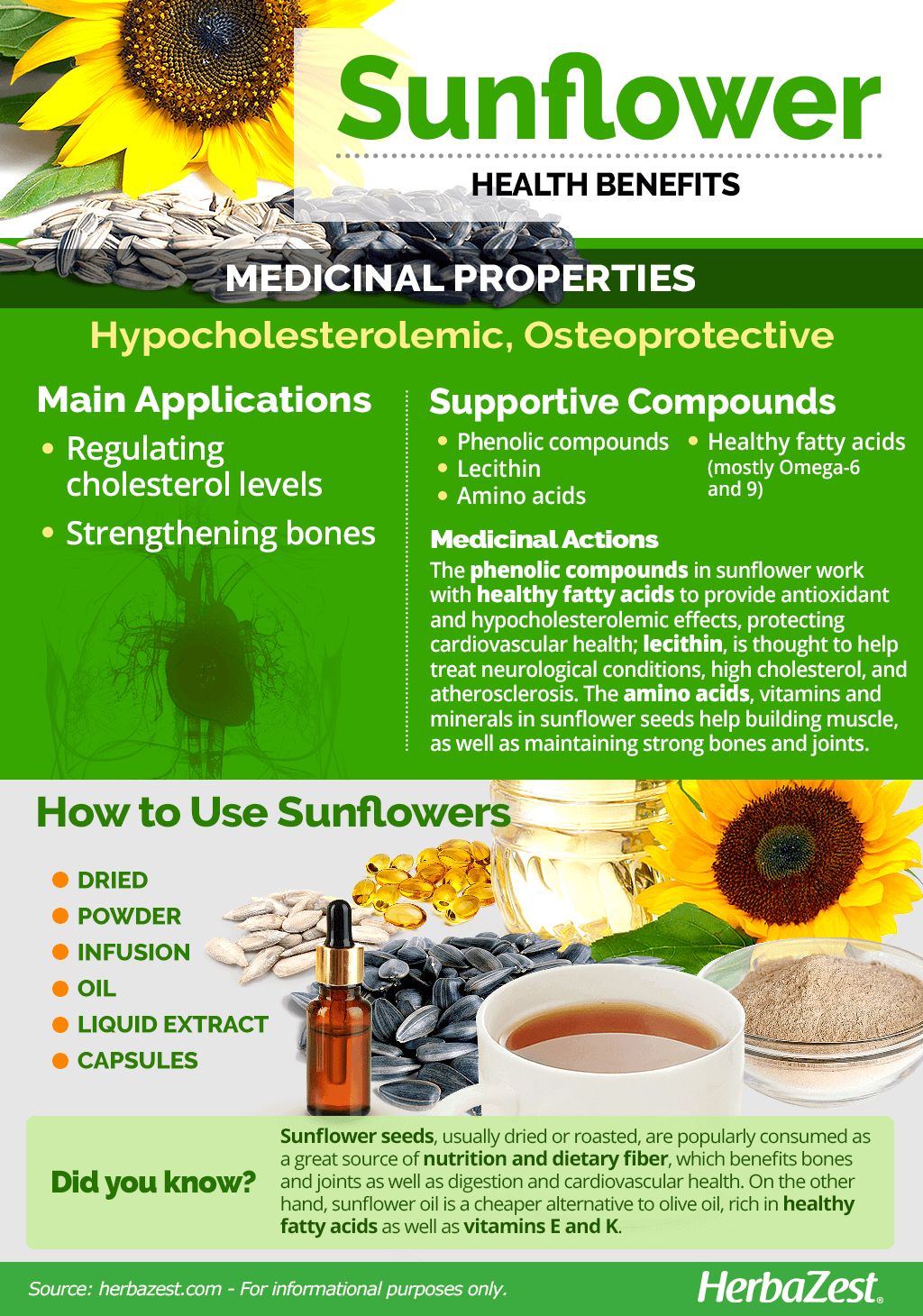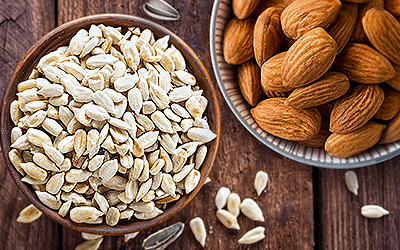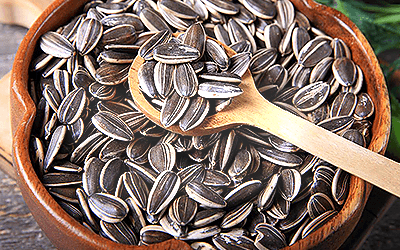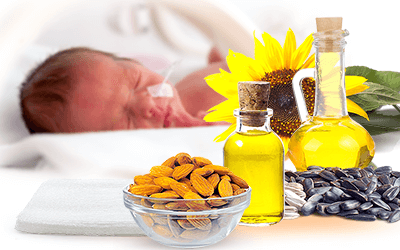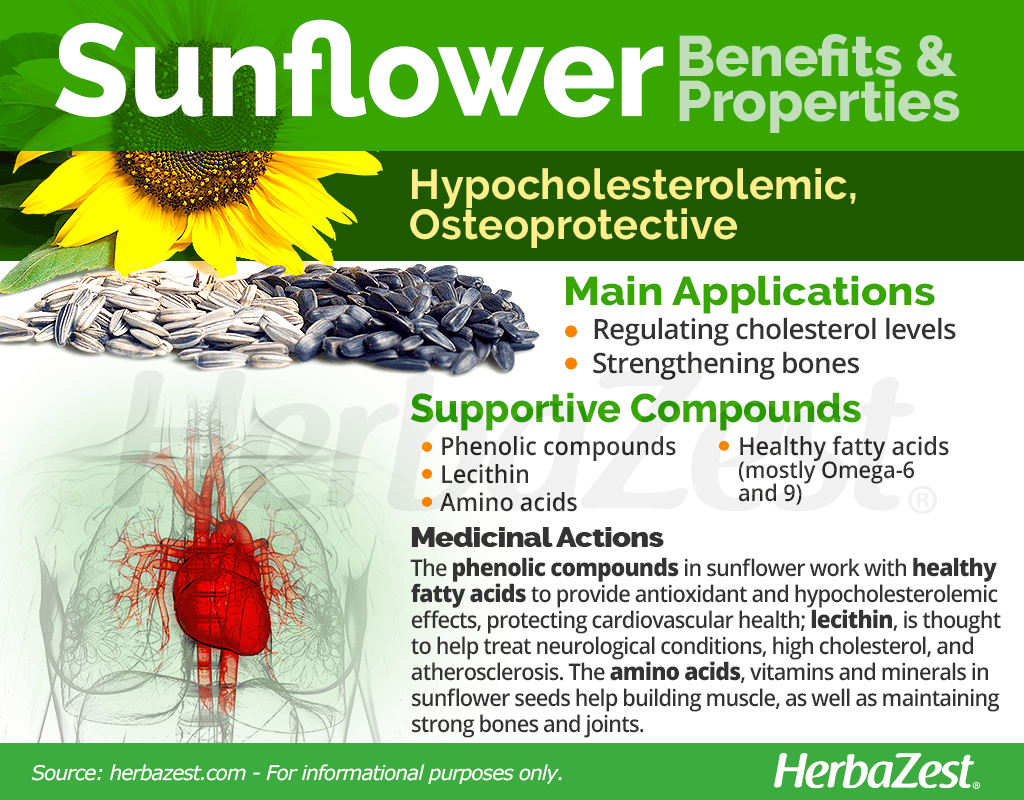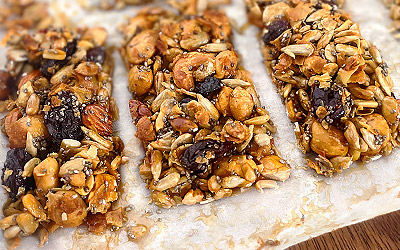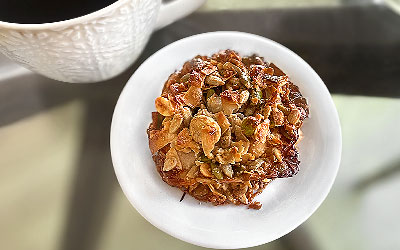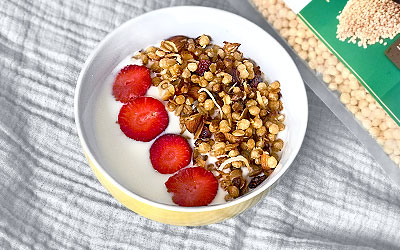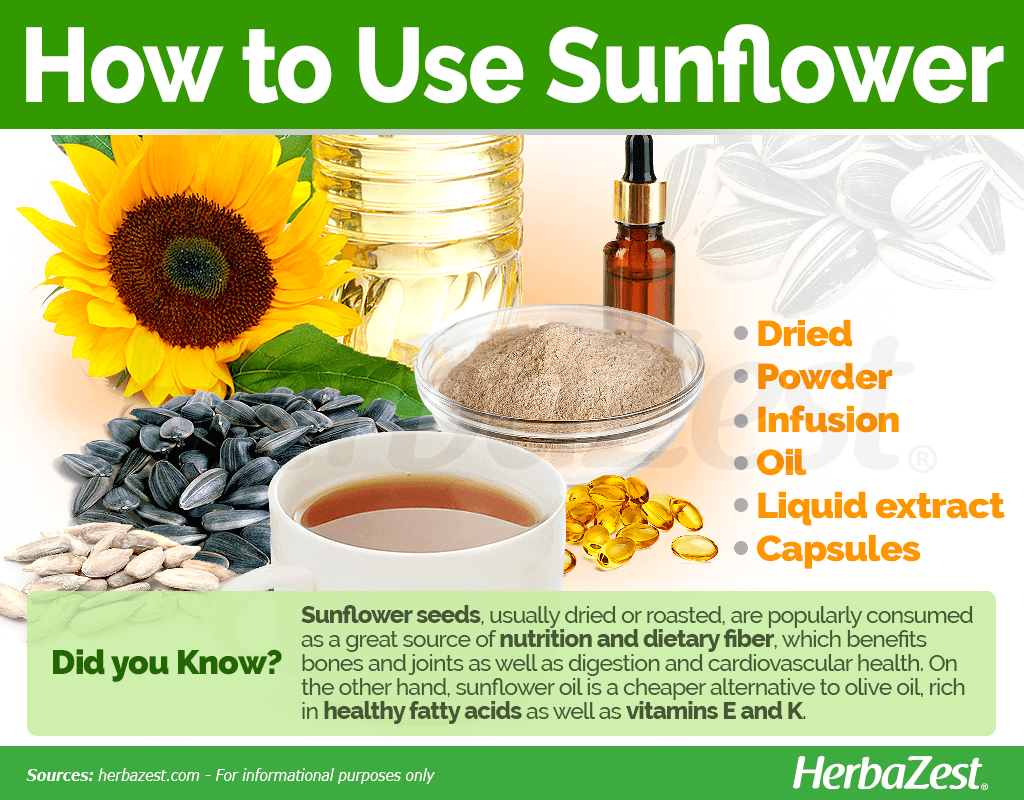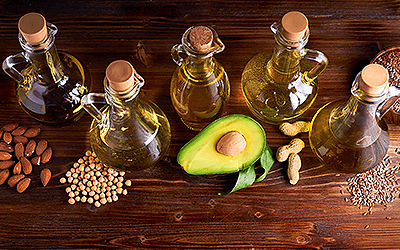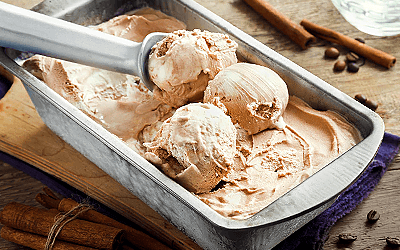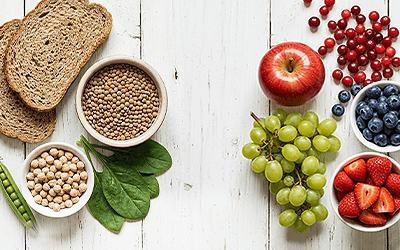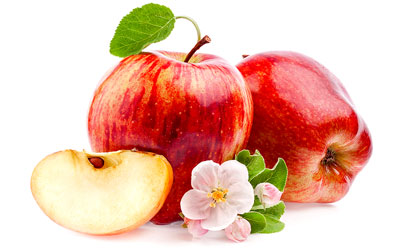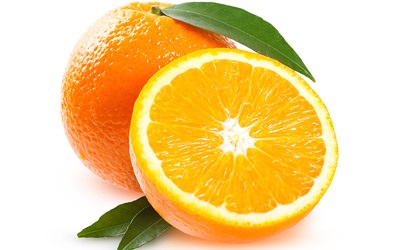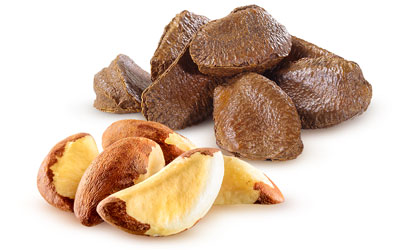Native to the Americas, the sunflower has enjoyed a privilege status due to its symbolic, ornamental, nutritional, and medicinal uses, both past and present. While the seeds are arguably the most economically important part of the plant, sunflower sprouts and leaves have also been used for nourishment and healing purposes.
Sunflower Medicinal Properties
Health Benefits of Sunflower
Sunflower's properties have been known since ancient times, and the whole plant, leaves, seeds and oil have been used for treating a variety of health conditions. Modern science has validated many sunflower benefits, mainly for:
Regulating cholesterol levels. Sunflower oil is rich in healthy fatty acids, which lower harmful cholesterol levels, thus reducing the risk of atherosclerosis and heart attacks.
Strengthening bones. Sunflower seeds contain high levels of vitamins and minerals that promote healthy bones and joints, preventing age-related diseases, such as osteoporosis and arthritis.
Other sunflower benefits include:
Promoting brain health. Sunflower seeds are considered brain food due to their high levels of essential minerals, which promote neural connectivity, whereas their antioxidant properties preserve cellular integrity, thus delaying age-related cognitive decline.
Aiding tissue regeneration. Due to its high amounts of healthy fatty acids and amino acids, sunflower oil is great for nourishing the skin, and also allows for a quick recovery after injuries. Its antioxidant properties help delay the external signs of aging.
The healing properties of sunflowers have found additional medicinal uses, such as reliving respiratory problems, treating colds and coughs, and relieving constipation.
How It Works
An assortment of phenolic compounds are found in Helianthus species, predominantly sesquiterpene lactones and diterpenes. Sunflower seeds contain up to 50% essential fatty acids, composed of omega-6 (polyunsaturated linoleic acid), a moderate amount of omega-9 (mono-unsaturated oleic acid), and a good amount of protein building amino acids. Palmitic and stearic saturated acids are present in quantities no higher than 12%.
Sunflower extracts are also rich in lecithin, a compound obtained from crude sunflower oil. Preliminary studies suggest that lecithin might help treat some neurological conditions, lower harmful levels of cholesterol, alleviate atherosclerosis, and restore memory and cognition.1
Cynarine is an organic acid found primarily in sunflower sprouts. This bioactive compound has antioxidant and anti-hyperglycemic effects, meaning it can help prevent potential damage from prolonged high blood sugar levels. Likewise, the tocopherol and linoleic acid in sunflower seeds also have antioxidant activity. This action also extends to the lungs, where sunflower seed extract has been shown to reduce the production of inflammatory proteins.
A combination of antioxidant compounds and dietary fiber are thought to be responsible for sunflower's hypocholesterolemic properties.
Other herbs with similar cardioprotective properties are chia, olive, and sacha inchi, whereas almonds, sesame, and quinoa are also beneficial for digestion and bone health.
Sunflower Side Effects
Sunflower oil is considered generally safe for oral and topical use; however, ingesting large amounts of unshelled sunflower seeds can lead to intestinal obstruction.
Sunflower Cautions
Some studies suggest that the consumption of sunflower oil increases the risk of breast cancer in postmenopausal women. On the other hand, the plant can trigger asthma and skin allergies in sensitive people. When taken as a supplement, the high amounts of vitamin K in sunflower extracts and oil can increase the risk of bleeding in people scheduled for surgery or those who experience physical trauma.
- Medicinal action Hypocholesterolemic, Osteoprotective
- Key constituents Phenolic compounds, lecithin, healthy fatty acids, amino acids
- Ways to use Capsules, Hot infusions/tisanes, Liquid extracts, Food, Powder, Essential oil, Dried
- Medicinal rating (3) Reasonably useful plant
- Safety ranking Safe
Sunflower Nutrition
Sunflower oil, commonly used with culinary purposes, is high in healthy fats as well as vitamins E and K, whereas sunflower seeds are the most popular way of reaping the nutritional benefits of the herb.
The dried sunflower seeds are a widely consumed snack that greatly contributes to overall health as part of a balanced diet. They are incredibly rich in muscle-building proteins, cholesterol-lowering fatty acids omega-6 and 9, and insoluble fiber for digestive aid.
Sunflower seeds are well-known for providing astounding amounts of minerals, particularly copper, which is essential in the production of red blood cells, as well as for keeping healthy bones, blood vessels, nerves and immunity; selenium, which is crucial for the production of antioxidant enzymes that prevent cellular damage as well as for reproductive and endocrine health; manganese, which helps the body form connective tissue, bones, blood clotting, and sex hormones as well as aiding with metabolic functions, calcium absorption, and blood sugar regulation; and zinc, which is essential for immunity, wound healing and the the breakdown of carbohydrates as well as for the senses of smell and taste.
Other minerals, abundant in sunflower seeds, include iron, magnesium, potassium and phosphorus, along with fair quantities of calcium.
Among the most abundant vitamins in sunflower seeds are vitamin E (alpha-tocopherol), which enhances immunity and ward off infectious diseases as well as improving blood circulation and preventing the formation of blood clots; and B-complex vitamins, all of which play an important role in metabolic functions and energy production and are also needed for liver, skin, hair and eyes health.
100 grams of sunflower seeds provide 584 calories, 42% of the recommended daily value for protein as well as 79, 34, and 7% DV of healthy fats, dietary fiber, and carbohydrates, respectively.
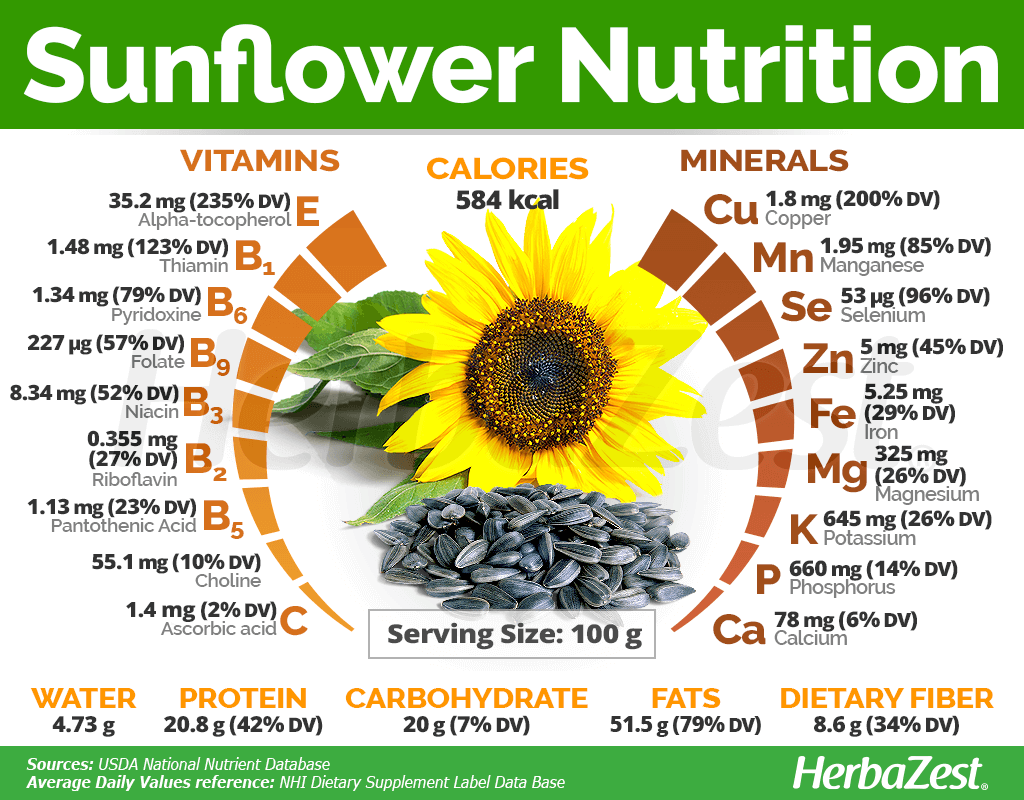
How to Consume Sunflower
The seeds of sunflowers are the most commonly consumed part of the sunflower, either as a snack or as an oil that is derived from the seed.
Sunflower sprouts are sometimes boiled and consumed in China and other parts of Asia.
Natural Forms
Dried. Sunflower seeds, usually dried and roasted, are popularly consumed as a great source of nutrition and dietary fiber, which benefits bones and joints as well as digestion and cardiovascular health. They're often sprinkled on salads or added to trail mixes.
Powder. Sunflower seeds are rich in lecithin, which is cold pressed and powdered. This powder is taken for preventing arteriosclerosis as well as for maintaining neurological and cardiovascular health.
Infusion. The dried petals of the plant can be made into sunflower tea, which is thought to have diuretic and astringent properties and can be consumed for treating edema, cough, and diarrhea.
Herbal Remedies & Supplements
Liquid extract. Because of its richness in phenolic compounds, sunflower's extract is used for nourishing skin and hair.
Oil. Extracted from the seeds of the plant, the healthy fatty acids contained in sunflower oil have proven useful for protecting brain functions as well as cardiovascular health.
Capsules. Sunflower lecithin, choline, and essential fatty acids can obtained in supplement form, which can be taken daily in standardized doses in order to reap the antioxidant and cardioprotective benefits of the herb.
Sunflower oil is a cheaper alternative to olive oil and, thus, used for various cooking and baking needs; it's likewise used for making margarine. In fact, sunflower seeds can be used for a number of other alternatives, depending on how they're processed: as substitute for peanut butter or coffee, for example. The seeds can also be ground into flour for baking bread.
- Edible parts Flowers, Seed
- Edible uses Oil
Growing
Sunflowers are characterized by their large, bright yellow, flower-like inflorescence, which can include up to 6000 tiny flowers. The plant also presents stout, erect, and hairy stems with strong taproots as well as coarse, hairy, and mostly alternate leaves. Common sunflower can grow anywhere from 2 - 10 feet (0.5 - 3 m) tall, and the heads are generally large and bright, about 3 - 6 inches (7.5 - 15 cm) across. Sunflowers naturally produce many branches with these flowering heads topping each.
Growing Guidelines
True to name, sunflowers require full sun in order to grow and will greatly benefit from plenty of water while they establish roots in fertile, well-drained soil.
They grow best when temperatures remain in the range of 55 - 85°F (13 - 30°C), and higher temperatures may reduce seed yield.
Sunflower appears tolerant of soils with a pH down to 5.5, but consider liming if the pH is below 6.0 to improve nutrient availability.2
Sunflowers are best planted anytime after soils have warmed to 50°F (10°C)3, approximately three to four inches (7 -10 cm) deep, and approximately 30 inches (80 cm) apart.
Although sunflower seeds can be started indoors, some people recommend sowing them directly into the ground in order to grow bigger sunflowers. This helps to ensure that the taproot doesn't become stunted if transplanting is delayed.4
Eventually, the tall, thin stalks will need support from stakes, but these might also help keep rodents and birds away. If not, they might require additional protection as their seeds and stalks are highly beloved by all manner of creatures.
They need high nitrogen levels for maximum yields as well as extra phosphorus and potash right before and during flowering.
Sunflowers are prone to diseases such as mildew and root rot as well as caterpillar and moth infestations.
More detailed information about growing sunflower can be found in the herb garden section.
- Harvested parts Flowers, Seeds
- Light requirements Full sun
- Soil Medium (loam), Well-drained
- Soil pH 6.6 – 7.3 (Neutral)
- Growing habitat Temperate climates
- Plant spacing average 0.9 m (2.95 ft)
- Potential insect pests Moths, Caterpillars
- Potential diseases Mildew, Root rot
Additional Information
Plant Biology
Sunflower (Helianthus annuus) is a species that is easily variable and hybridized with other species. When cultivated (as opposed to growing wild), the flower heads are characteristically and noticeably large.
Sunflowers are heliotropes - meaning their faces follow the course of the sun across the sky.
Classification and Description
Helianthus annuus is a member of the Asteraceae family, which comprises over 23,000 species. Other important members of the also called daisy family are artichoke (Cynara cardunculus), calendula (Calendula officinalis), chamomile (Matricaria chamomilla), chicory (Cichorium intybus), dandelion (Taraxacum officinale), and feverfew (Tanacetum parthenium).
Varieties and Subspecies
Most of the sunflowers grown and sold today are a hybrid of multiple species, both wild and cultivated. This genetic diversity allows for strength, the weeding out of unwanted characteristics, total oil content, and ornamental value. In its wild form, sunflower actually has many heads, but a large, one-headed cultivar was developed in Russia and then reintroduced to the Americas. Some variants grow to be 9 - 16 feet (3 - 5 m) tall, or have maroon petals.
Historical information
The tall, bright yellow face of sunflowers was a symbol of sun deities in Central and South American cultures as far back as 3000 BCE, and the plant played an important role in both the religion and culture of northern Native Americans. Medicinally, these historic cultures used sunflower to treat colds, snakebites, wounds, lung ailments, and respiratory problems, to name a few.
Sunflower can be recognized as the representative flower of places as far apart as Kansas, Ukraine, New Mexico, Arizona, Spain, and the city of Kitakyushu in Japan. It is also the subject of the famous still life paintings by the Dutch painter Vincent van Gogh.
Economic Importance of Sunflower
Because of the relative variety of uses for sunflower, such as for biodiesel, a cheaper alternative to olive oil, or even as a highly popular snack across the globe, sunflower is cultivated in many countries, and the amount of land devoted to this crop is growing every year.
In 2013, countries such as Argentina, Bulgaria, China, France, Hungary, Spain, Turkey, and Tanzania all produced over one million tons of sunflower seeds each, with Ukraine and Russia taking the lead with over ten million tons.
Popular Beliefs
Sunflowers make up a significant part of the creation myths of the Onondaga people in North America. When plentiful, sunflowers stood as an omen of a good harvest year and bountiful meat.
Many indigenous peoples of the Americas revered the sunflower for its beauty and healing power. The oil from the seeds was used to paint and decorate the body for ceremonial rites, and purple, black, and yellow dyes extracted from the seeds and flowers were used for coloring baskets and weaving.
Other Uses
Fodder. Nowadays, sunflower seeds are used for feeding birds, chicken, cattle, and other farm animals.
Fuel. Sunflower is also becoming a growing source of biofuel in many countries.
Fiber. The stems have been used to make commercial fiber, which is then used for fabrics and paper.
Lesser common uses of sunflower seed hulls include manufacturing ethyl alcohol and furfural, a colorless liquid used in synthetic resin manufacture.
- Other uses Animal feed, Paper, Fiber, Fuel
Sources
- American Herbal Products Association's Botanical Safety Handbook, p. 437
- Edible & Medicinal Flowers, p. 75
- International Journal of Molecular Medicine, Aqueous extract of the Helianthus annuus seed alleviates asthmatic symptoms in vivo, 2008
- Nuts and Seeds in Health and Disease Prevention, p. 130
- Purdue University, Helianthus annuus L.
- Texas A&M Agrilife Extension, Helianthus annuus
- The Natural Health Dictionary
- USDA Plants Database, Annual Sunflower
- FAOSTAT
- Journal of Agricultural and Food Chemistry, Cynarin-rich sunflower (Helianthus annuus) sprouts possess both antiglycative and antioxidant activities, 2008
Footnotes
1 Wood JL, Allison RG (1982); Effects of consumption of choline and lecithin on neurological and cardiovascular systems; Federation proceedings.
2,3 Myers, Robert L. Ph.D (2002); Alternative Crop Guide; published by the Jefferson Institute. Retrieved Nov. 19th, 2019.
4 Mahaney, Erin (2018); Growing and Roasting Sunflower Seeds; University of California. Retrieved Nov. 19th, 2019.
